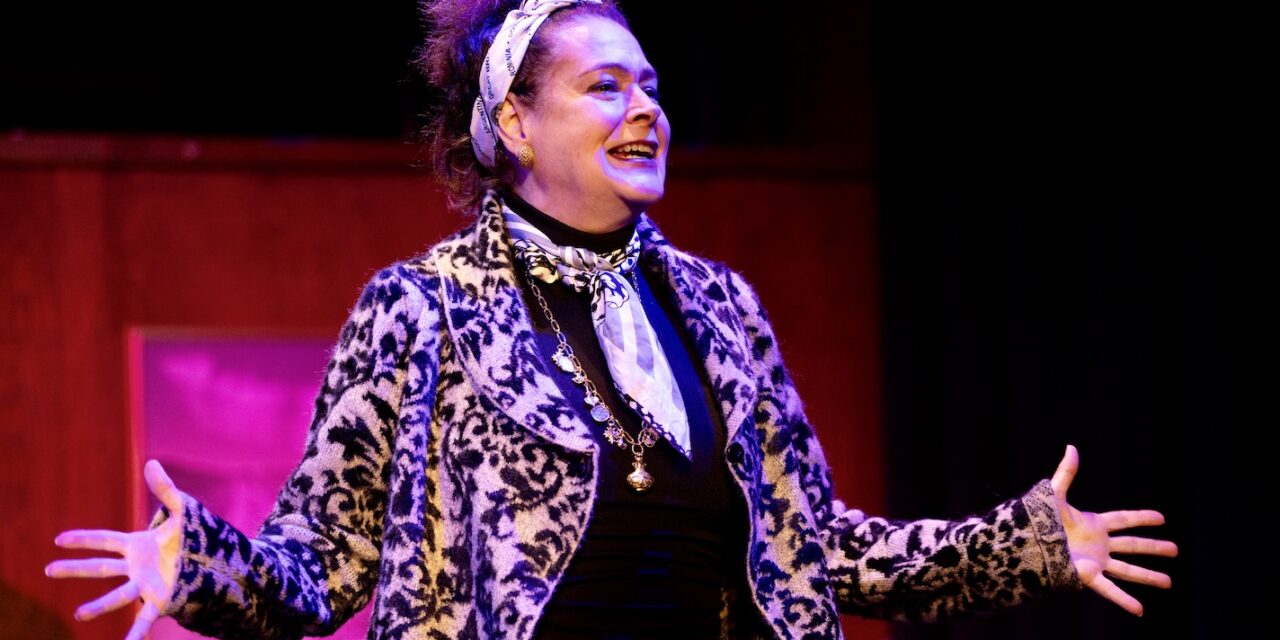Theater Review by Samuel L. Leiter . . . .
Rider McDowell’s stingless Ode to the Wasp Woman, Off-Broadway at the Actors Temple Theatre, dramatizes the sad, tawdry fates of four Hollywood actors: Carl “Alfalfa” Switzer (Josh Alscher), who rose to fame as the squeaky-voiced kid with a stubborn cowlick in The Little Rascals movies; Susan Cabot (Sean Young), whose career ended in such Roger Corman B-flicks as The Wasp Woman; George Reeves (Douglas Everett Davis), best known for the 1950s TV series in which he played Superman; and Barbara Payton (Payton Georgiana), whose promising career descended to the level of starring in Bride of the Gorilla. Each died violently, either by their own or someone else’s agency.
A program note from “The Producers” tells us that, according to the playwright, “There is no moral here . . . no career advice, just a grim and entertaining little narrative about four extraordinary but unlucky people who intrigued him as a boy.” Grim, yes; entertaining, no. As for this group of actors being extraordinary, I’ll take a pass. But they certainly had hard luck.

Their stories have been told again and again in books, magazines, on video, and in films. McDowell compresses them into a sequence of four short playlets, linked by brief speeches given by one of the other members of the tragic quartet, over the space of two excruciating hours. The set and furnishings remain the same, the latter being rearranged as necessary. I’ve seen thousands of plays over the past seven decades, around 2,000 just since I began reviewing 11 years ago; it pains me to announce (unless memory fails me) that Ode to the Wasp Woman is one of the worst.
To tick off here all the artistic atrocities on view would be useless; besides, the list would go on for pages. For the sake of brevity, let’s just say that the scenery (by Christian Fleming), the lighting (by Maarten Cornelis), and the costumes (by Pearl Gopalani) are the definition of amateurishness; the acting—which requires six of the eight actors to play two or more roles—awful; and McDowell’s direction, if you could call it that, is even clumsier than his writing.


Of course, a production like this usually comes with its share of laugh-worthy gaffes. At one point, for example, an actress reacted with surprise at the sound of a doorbell; the bell rang, however, after she heard it, not before. At another moment, an actor was looking at two small piles of books, reading off their titles from the upstage group. As he mentioned one, he realized that that the title was that of a downstage group, forcing him to make the awkward transition; of course, no one in the audience could actually see what any of the titles were.
How something like Ode to the Wasp Woman could make it to the New York professional stage in the supposedly sophisticated 2020s would need Hercule Poirot to disentangle. Even more mysterious is why one-time movie star Sean Young—who has had her own notable run-ins with Hollywood’s celebrity-bashing machine—would, at 63, choose so obvious a fiasco as this for her New York stage debut. Judging by the egregious chintziness of the show’s production values, it sure couldn’t have been for the money.


Whatever the motive, Young does herself no favors in this farrago, in which she appears only in the Susan Cabot scene and doesn’t return until the curtain calls. By the way, she gets to warble a song as part of her performance, a meaningless, distracting device McDowell employs for each of his four victims.
Even the house management at the Actors Temple—a theater district synagogue used for plays and musicals—could use some help. Serving as a lobby is a steep flight of marble stairs on which the audience is forced to stand until the house is opened. When I went, we weren’t let in until 7:20 for a 7:30 show.
Then, regardless of the fact that there were only 15 or 16 of us, we had to sit in the ticket-assigned seats, meaning most of us were toward the rear of the long, narrow auditorium, which is on a flat, unraked floor. Thus, a huge, tunnel-like gap existed between the bulk of the spectators and the high, raised stage, exaggerating the aesthetic distance. I expected someone to ask us all to move forward to create a more compact and intimate environment, but no one ever did.
The title already has been taken but Ode to the Wasp Woman could more accurately be called “The Play that Goes Wrong.”
Ode to the Wasp Woman. Through January 31 at the Actors Temple Theatre (339 West 47th Street, between Eighth and Ninth Avenues). www.waspwomanplay.com
Photos: Maria Baranov
Cover Photo: Sean Young


















